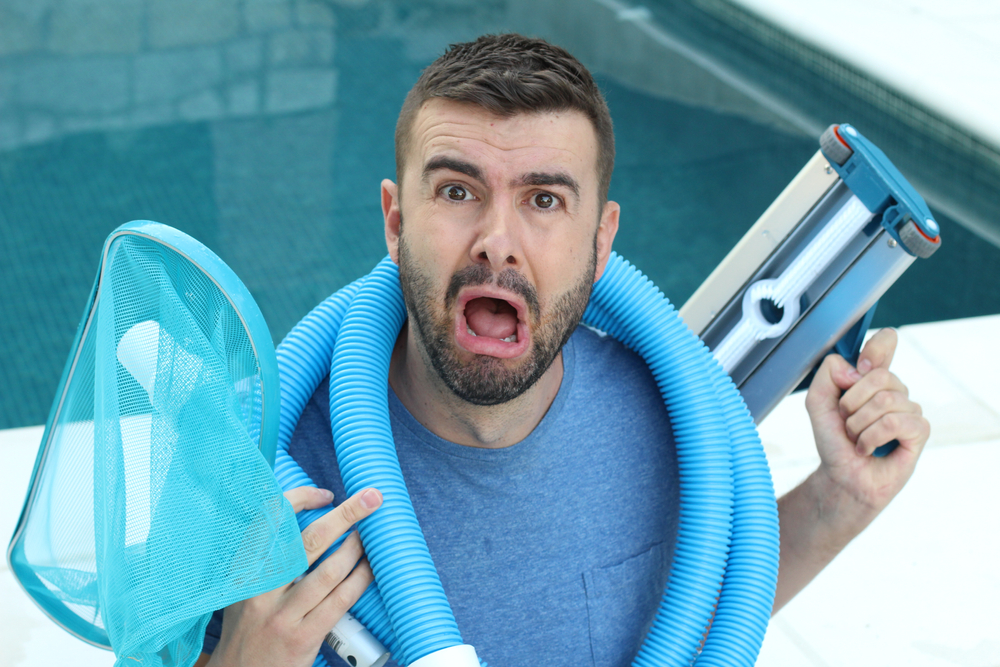When the weather warms up, it’s time for pool season! Are you ready to make sure your pool is safe and ready for fun? This guide will help you get everything right for your pool opening. You’ll be able to start the summer with a splash.
Key Takeaways
- Properly remove, clean, and store your pool cover for the season
- Fill your pool and maintain the proper water level
- Thoroughly clean and vacuum your pool to remove debris
- Inspect and clean your pool filter for optimal performance
- Prepare and test all pool equipment before startup
- Test and balance your pool water chemistry
- Shock and sanitize the pool water to ensure a clean start
Remove, Clean and Store Your Pool Cover
First, take off your pool cover to get it ready for summer. This is key to making it last longer. Begin by getting rid of any dirt or water on top of it.
After that, take it off carefully to avoid tearing. Start by loosening any safety cover anchors. This step helps avoid damage and accidents.

Cleaning the Pool Cover
Cleaning your pool cover well keeps it in good shape. Automatic covers can be cleaned whether they’re wet or dry. Use a leaf rake or skimmer net to clear off dirt easily.
With tarp covers, a quick rinse from a hose is enough. Consider using a leaf catcher to make things even easier. It can get rid of most leaves and other debris in one sweep.
Storing the Pool Cover
After cleaning, let your pool cover dry completely. Then, fold or roll it up. For best results, roll it in four-foot sections. Store it in a safe, cool, and dry place.
Avoid hot storage areas to prevent damage. Following these steps will keep your pool cover in great shape. If you need help with your cover, reach out to Hot Springs Pools & Spas.
“Proper pool cover storage is crucial for maintaining its functionality and longevity. Following the recommended guidelines will help ensure your cover is ready for use when the next swimming season arrives.”
Taking care of your pool cover is a vital step in getting your pool ready. With the right removal, cleaning, and storage, your pool cover will be good to go the next summer.
Fill Your Pool and Maintain Proper Water Level
As the weather gets warmer, it’s time to get your pool ready for swimming season. This starts with making sure the water level is right and keeping it that way all season.
Filling your pool means getting the water level halfway up from the skimmers to the tiles. This spot is perfect for skimming, cleaning the water, and running the pool well.
- Use a garden hose or fill line to add water to your pool as needed.
- Keep an eye on the water level, especially after lots of swimming or when it rains. Make sure to add more water as needed to keep it at the halfway mark.
- Check if your pool has an auto-fill feature. It should be adding water back in as it goes down.
Having the right water level in your pool is very important for a few reasons:
- Optimal Skimming and Filtration: With the perfect water level, your skimmer can get rid of stuff floating on the water. Your filter can also work its best.
- Equipment Protection: If your pool pump runs with too little water, it might break. This could lower the life of your pool gear.
- Aesthetics and Safety: The right water level makes your pool look better and be safer and more fun for swimming.
Keep a close watch on the water level and adjust as needed. This will make sure your pool is top-notch for summer activities. Remember, getting the water level just right is key to a great and healthy swimming area.
Clean and Vacuum Your Pool
When your pool is filled, it’s key to clean it well. A pool cleaning and vacuuming routine is crucial. It removes any debris or build-up from the off-season.
Manual Pool Vacuuming
First, use a manual pool vacuum. It sucks up leaves, twigs, and other pool debris from the bottom and sides. This is important because automatic cleaners might not handle very dirty water or lots of algae well. It’s a good idea to get a pool vacuuming guide to learn the best methods.
- Attach the vacuum head, hose, and pole to your pool’s skimmer or use a skim vac plate.
- Fill the hose with water to get rid of air bubbles and improve suction.
- Start vacuuming from the shallow end, moving towards the deep end slowly to not stir up dirt.
- If suction decreases, check and fix any issues.
- After vacuuming, clean the equipment well, and adjust the water’s chemistry as required.
Keeping your pool’s pump and filter in good condition is crucial for effective pool vacuuming. Also, think about a robotic cleaner like the Polaris Vac-Sweep 65 for easier and better pool cleaning.
| Service | Cost |
|---|---|
| Initial Power Vacuum Service | $135 per hour |
| Initial Vacuum Service for Pools with Excessive Algae and Debris | $125 plus cost of needed chemicals |
“Regular cleaning and vacuuming are key to a healthy and welcoming swimming pool.”
Inspect and Clean Your Pool Filter
With warm weather coming, it’s time to prepare your pool. Inspecting and cleaning your pool filter is crucial. It keeps your pool water clean, clear, and safe for swimming.
First, remove the filter media, which can be sand, cartridge, or D.E. Check it for any damage like cracks or holes. If it’s damaged, replace it. Pool filter maintenance includes regularly changing the filter media.
Then, look at the filter’s O-rings. These rubber seals prevent leaks and keep the filter working well. Including filter O-ring inspection in your maintenance routine is wise. Replace any O-rings that are old or cracked.
For sand filters, backwashing and adding new sand or D.E. is important. This step maintains the filter’s cleaning ability and water flow. Filter media replacement keeps your pool’s water quality high.
“Proper filter maintenance is key for a clean and healthy pool all season.”
Remember to clean the filter housing and other system parts. A good spray with a garden hose and wiping them down will help. This small effort can significantly improve your filter’s performance.
Taking time to look after your pool filter is crucial for a great swimming season. A working filter is essential for a clean and welcoming pool. Your family will enjoy it throughout the summer.
Pool Openings: Prepare and Test Equipment
Before you start your pool, checking the equipment is crucial. Inspect the pump, filter, and other gear. Make sure everything looks good and works right.
Pool Pump Preparation
First, fill the lines with water to avoid air and help the pump work well. Make sure the plug and wires are okay. Clean out the pump basket. Look for leaks and wear on the pump. Fix any problems you find.
Pool Filter Startup
If you have a sand filter, clean the sand with a special cleaner. For cartridge filters, have new cartridges ready. For D.E. filters, check if you have enough powder for the grids.
Pool Equipment Inspection
Check all pool gear, like the skimmer and return jets. Make sure they work right. Repair or replace anything that doesn’t. Remember to use Teflon tape to stop leaks.
Testing your pool equipment well now will prevent trouble later. Fixing things early makes the pool opening go smoothly. Then, you’re all set for a fun and relaxing summer.
| Recommended Pool Opening Supplies | Estimated Cost |
|---|---|
| Liquid Algaecide (40% of water container capacity) | $20 |
| Pool Shock (Initial 2 gallons) | $30 |
| Filter Cleaning Service (DE or Cartridge) | $69 |
| Saltwater Chemical Bundle (with 15% discount) | $149 |
| Standard Chemical Bundle (with 15% discount) | $83 |
| Salt Cell Cleaning Service | $49 |
| Cover Rinsing Service | $75 |
Proper preparation and testing help ensure your pool opens without a hitch. This means you’re ready for an amazing summer of swimming and fun.
Test and Balance Water Chemistry
Getting your pool ready for summer starts with water chemistry. Use a pool test kit to check pH, chlorine, alkalinity, and calcium. These levels ensure your swim is both safe and enjoyable.
Start by understanding why pool water testing is so important. It’s key to check your pool water two to three times each week. Use test strips or a kit to track these levels.
Now, let’s talk about balancing the water. Here are the target ranges for each chemical:
- pH: 7.4 – 7.6
- Alkalinity: 80 – 120 ppm
- Calcium Hardness: 200 – 400 ppm
- Chlorine: 1 – 3 ppm
- Cyanuric Acid: 30 – 50 ppm
If levels are off, make the necessary adjustments. For low pH, use a pH increaser. High alkalinity requires a reducer. Keeping things in balance stops algae and protects your pool.
| Pool Water Parameter | Ideal Range | Adjustment Chemicals |
|---|---|---|
| pH | 7.4 – 7.6 | pH Increaser, pH Decreaser |
| Alkalinity | 80 – 120 ppm | Alkalinity Increaser, Alkalinity Reducer |
| Calcium Hardness | 200 – 400 ppm | Calcium Hardness Increaser |
| Chlorine | 1 – 3 ppm | Chlorine Tablets, Liquid Chlorine |
| Cyanuric Acid | 30 – 50 ppm | Cyanuric Acid Increaser |
By regularly testing and adjusting your pool’s water, you ensure a fun and clean summer for all.
Shock and Sanitize the Pool Water
Getting your pool ready for summer is key. Shocking your pool means adding lots of chlorine. Or, you use other sanitizers to kill any harmful stuff like bacteria or algae.
For those with systems like the Clear Comfort AOP, shocking is different. They use hydroxyl radicals, making them need less traditional chlorine boost.
The Importance of Shocking Your Pool
Shocking your pool does a lot of important jobs. It:
- Makes the water safe by killing bacteria and algae.
- Gets chlorine or other sanitizers back to the right levels.
- Cleans out junk in the water to keep it clear.
- Gets the pool ready for the summer so you can have fun safely.
Whether you shock your pool with chlorine or not, always follow the instructions. Make sure the water is balanced before swimmers jump in.
Shock Treatment Considerations
There are key things to think about when shocking your pool:
- Shock Dosage: The shock amount depends on pool size, water temp, and existing chlorine. A rule of thumb is 1 pound for every 10,000 gallons.
- Shock Type: Pool shocks come in many forms. Pick the one that’s best suited for your pool and your needs.
- Timing: Apply the shock in the evening. This way, the chlorine isn’t eaten up by sunlight right away. Wait for it to work before swimming.
- Water Balance: Keep your pool’s pH, alkalinity, and hardness correct. This helps the shock do its job better.
By carefully shocking your pool following these steps, you’ll have a great swimming season ahead.
“Proper pool shocking and sanitization is the key to a safe and enjoyable swimming season. It’s a crucial step that shouldn’t be overlooked.”
Conclusion
By following these steps, your pool will be ready for summer fun! Make sure to check the water’s chemistry often. This way, you can keep it safe and nice for swimming all summer long.
Do your own pool care or trust Majestic Pools, it doesn’t matter. What’s important is to keep up with your pool’s maintenance. Spend time opening your pool now. This will help you enjoy the sunny days and relax in your backyard more.
Have a great time swimming with your loved ones! A well-prepped pool means endless fun in the sun.


